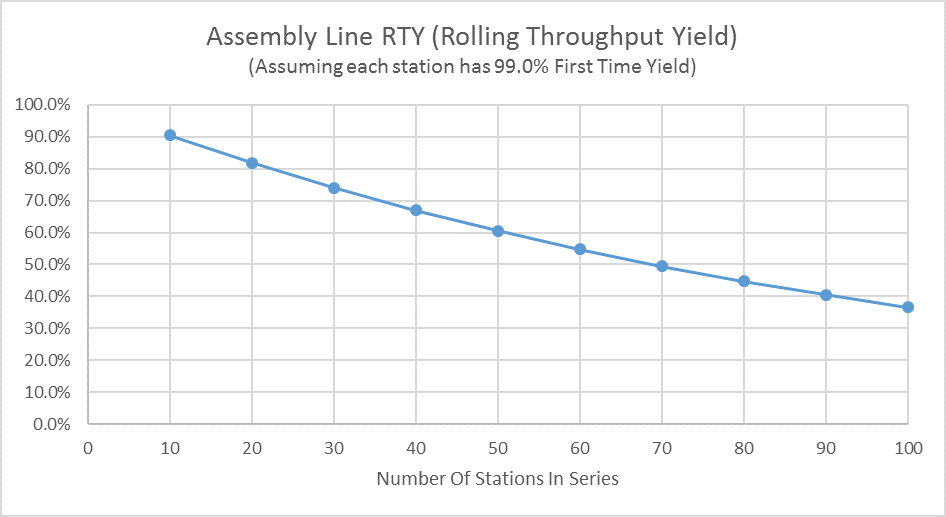Contributed by: Sciemetric Staff

In our last post, we explained the benefit of measuring the efficiency of a production line by first time yield (FTY) instead of overall yield/output. In this post, we will discuss the time and cost efficiencies than can result by focusing on making improvements to your FTY.
LOOKING TO IMPROVE FIRST TIME YIELD? LEARN ABOUT SCIEMETRIC'S APPROACH
To recap, overall yield is the total final output of a manufacturing line. It includes any units that had to be reworked in a repair bay because of defects or errors before earning the stamp of approval.
First time yield, on the other hand, looks only at those units that made it through a station, assembly process, or all the way down the line and out the door, without any defects or errors that required rework.
As discussed in the previous post, FTY must be calculated for each individual process or test station where the end-goal is a pass/fail result. These numbers are then multiplied together to provide the overall, end-to-end FTY for the production line. This is also known as Rolling Throughput Yield, or RTY.
From the chart below, consider the example of 50 stations in series. Each station produces 99 percent FTY. This may sound good, but by the time you reach the end of the line, the RTY is only about 60 percent. This means the scrap or rework rate is 40 percent!

The moral of this story? The more stations on a line, the greater the need for a quality assurance process that ensures FTY at each station is as close as possible to 100 percent.
But of course, your next question is going to be: how much will the required improvements cost you to achieve these numbers, and is it worth it? It depends on how high of a rework rate is hidden in your overall yield figure, and how much the rework adds to the average production cost per unit.
Case Study: Boosting FTY from 90 to 98 percent enables 3M+ in annual savings
Let’s look at a product that costs $5,000 to manufacture – $2,500 for material costs and $2,500 for transformation costs. The annual target production run rate is 10,000 units and the overall FTY (or RTY) is 90 percent. If the manufacturer doesn’t re-work the failed units, then 11,112 units must actually start production to achieve the target output of 10,000. This results in $5.6 million in scrapped products – millions of dollars that’s wasted every year. This has another consequence – it also increases the total cost to manufacture the product from $5,000 per unit to $5,556.
Now assume that the manufacturer implements a re-work process that recovers 80 percent of those failed units. This boosts overall yield from 90 to 98 percent (note that FTY remains at 90 percent). The cost of this re-work is 50 percent more than the initial transformation cost, so $3,750 per unit instead of $2,500.
Now, this does appear to be a worthwhile investment considering that $5,000 has already been committed to the failed unit. But look at it this way – total rework costs amount to $3.8 million per year. This boosts total average production cost per unit from $5,000 to $5,485.19.
Now, what if we could raise FTY from 90 to 98 percent – hitting the same yield without the cost of rework?
Total average production cost per unit would be $5,102.04, for a total savings per part of $383.15. That adds up to about $3.83 million in savings per year.
The trick, of course, is identifying how to make the productivity improvements at each station on the line that will drive this FTY increase—which is where Sciemetric’s in-process test and monitoring solutions come in.
LOOKING TO IMPROVE FIRST TIME YIELD ON YOUR LINE? LEARN HOW SCIEMETRIC CAN HELP
How do you achieve these improvements? Is it worth it?
To make these improvements at your stations (and across your line), you need to collect and analyze the right data to reduce the flaws and defects that undermine FTY. Sciemetric has the in-process test and monitoring capabilities combined with data collection and analysis tools to help you achieve that. Take the above scenario–a moderate upfront investment could pay off by saving your plant millions per year.
Even a modest increase in FTY can make a big difference. Take the above example again, with FTY increased by just two percentage points, to 92 percent. This would still generate costs savings greater than from boosting total yield to 98 percent through rework.
Is it worth it for your team to emphasize FTY improvements over total yield? It depends on how important it is for you to cut production costs and drive quality to remain competitive. For discrete manufacturers, improving FTY, even modestly, invariably yields the most benefit for their bottom line.
Want to learn more? Click here to read our whitepaper, “The ROI of Improving First Time Yield”.
Contact us to learn more about how Sciemetric’s in-process test and monitoring solutions could be applied to improve efficiency and production costs on your line.

